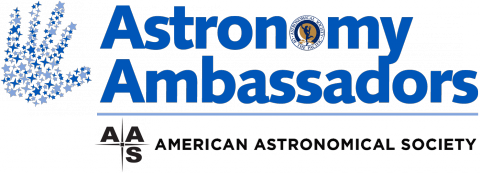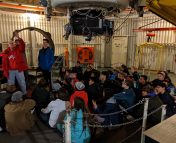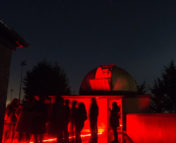This guest post is by Meredith L. Rawls, a graduate student at New Mexico State University. She can be found at http://astronomerrdiff.wordpress.com or on Twitter at @merrdiff
Imagine you have the following sketch. Your job is to get a room full of people to accurately reproduce the sketch themselves. The caveat? Only you can see it. And you can’t show it to anybody else – you can only describe it in words.
Now, the picture is your favorite astronomy research topic, and the room full of people is the public. Or an introductory classroom. How would you do?
This is not easy stuff. If you go to graduate school in astronomy, chances are good that you will spend time teaching undergraduates in some capacity and participating at public events like observatory open houses. These activities are sometimes viewed as a waste of time by more senior researchers, and are dumped in graduate students’ laps. On the contrary – this is some of the most important work you will do. It is crucial to educate the public about science in order for our nation and species to thrive, and that is not going to happen if scientists don’t learn to reach out and share their passion.
The Astronomy Ambassadors program is one way for early-career astronomers to learn crucial outreach skills. Started in January 2013 by the American Astronomical Society (AAS), the program provides a series of workshops and resources with the goal of improving astronomers’ ability to effectively communicate with students and the public. But the benefits of being an Astronomy Ambassador don’t stop there – the techniques you learn also apply when you are discussing and presenting research to colleagues and specialists.
I am delighted to be a member of the inaugural class of Astronomy Ambassadors. Throughout the two-day workshop, we heard from experts in education and public outreach, and got the chance to try many hands-on exercises for ourselves. We worked in groups to design outreach activities that would have a lasting impact, discussed how “random acts of education and public outreach” are ineffective in the long run, and brainstormed new ways to get involved in our communities. To support this last piece, we learned strategies to seek out and stay in contact with teachers and other community leaders who are interested in hosting outreach volunteers more than once.
In the months since January, our class of Ambassadors has stayed in touch sporadically through an online forum and recorded logs of our outreach efforts. These logs showcase the different activities we have all led across the country in countless different settings, and help us see what does and doesn’t work in different situations. Together, we are working to make a real difference in science literacy.
Let’s return to the drawing exercise. What are some techniques you might use to improve the chances your audience will understand, and succeed? Based on what I learned during the Astronomy Ambassadors weekend, you might…
- Give an overview before asking participants to start drawing
- Provide thorough context, and repeat each instruction before moving on
- Pay close attention to pacing – in particular, don’t go too fast
- Have participants work independently to start, and compare their work later
- Describe concepts in more than one way – for instance, perhaps the background landscape is an S-curve, a sine wave, a rolling hill, a snake, and a roller coaster track
- Give a recap or review of the big picture at the end

This advice, in a general sense, can be applied in many different communication situations. And I can think of many more suggestions to add to the list! But these things don’t come naturally – you have to practice, and you have to try different strategies in different situations to see what works best. This is what being an Astronomy Ambassador is all about. Ambassadors take the next step beyond just showing up to teach or volunteer – we share science in an accessible way to make a real impact.
Do you want to be an Astronomy Ambassador? Read more and apply to attend the workshop at the January 2014 AAS meeting here.





Trackbacks/Pingbacks